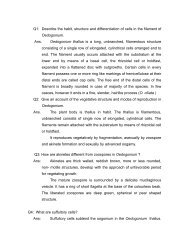Morphology of Marsilea Systematic position Kingdom : Plantae - CEC
Morphology of Marsilea Systematic position Kingdom : Plantae - CEC
Morphology of Marsilea Systematic position Kingdom : Plantae - CEC
Create successful ePaper yourself
Turn your PDF publications into a flip-book with our unique Google optimized e-Paper software.
shoot and leaf. Hypobasal half produces root and foot. Hence the<br />
development is described as lateral. In quadrant embryo, the next divisions<br />
are irregular. At the time <strong>of</strong> differentiation <strong>of</strong> different primordia in the embryo,<br />
the adjoining cells <strong>of</strong> megagametophyte divide periclinally, forming a thick<br />
calyptras, which encloses and protects the developing embryo. The calyptra<br />
is greenish in colour. Large number <strong>of</strong> rhizoids may develop from the base <strong>of</strong><br />
calyptra. The embryo gives rise to the young seedling that penetrates through<br />
the calyptra and grows into a sporophyte (Fig. 16).<br />
Fig. 16 <strong>Marsilea</strong>: stages in the development <strong>of</strong> embryo - A-E, early developmental<br />
stages; F, mature female gametophyte bearing young embryo surrounded by the<br />
calyptra; G, median-longitudinal section <strong>of</strong> the mature female gametophyte.<br />
Life cycle: In the life cycle <strong>of</strong> <strong>Marsilea</strong>, we find alternation <strong>of</strong> generations.<br />
<strong>Marsilea</strong> plant is a sporophyte, which is the dominant phase in the entire life<br />
cycle. The sporophyte comprises rhizome, roots and leaves. It reproduces<br />
vegetatively, as well as by means <strong>of</strong> spores. The spores are formed in<br />
sporangia on specialized structures called sporocarps. The sporocarps bear<br />
two kinds <strong>of</strong> asexual spores which are formed after meiosis and are, thus<br />
haploid (meiospores). The smaller spores are known as microspores. They<br />
are produced within microsporangia. The larger spores are known as<br />
megaspores, which are formed in the megasporangia. Both the sporangia are



